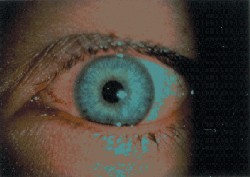We are in a special time in contact lens history, he says. [Never before] have we had lenses that are metabolically safer than silicone hydrogels.
In 2004, the industry was inundated with press releases and articles that showed these lenses to be metabolically safer for the eye, due to their high oxygen transmission. So, we decided to ask contact lens specialists how they felt about offering silicone hydrogel contact lenses to patients who are perfectly content in their current contact lenses. They offer these four reasons why you should offer these patients silicone hydrogels.
 |
| One way to introduce silicone hydrogle contact lenses to these patients: Ask pro-bing questions about how the patient"s eyes feel in their current lenses. |
contact lenses is unfair to the patient.
Optometrist and practice management consultant Gary Gerber, of Hawthorne, N.J., believes that giv- en the long-term eye health benefits, not presenting silicone hydrogel contact lenses to these patients is improper. These patients may say that they are doing fine in their current lenses, but we have to think of the long-term effects of contact lens wear, and the fact is more oxygen is better for their eyes, he says. Therefore, since we know that silicone hydrogel contact lenses offer high oxygen, we owe these and other patients the right to know that these lenses are out there.
The argument for silicone hydrogel use in patients who have daily wear contact lenses, however, is somewhat less compelling, says optometrist Joseph P. Shovlin, of Scranton, Pa. The subtle signs of hypoxia, such as neovascularization, and the not-so-subtle signs, such as myopic creep, seem not to be as present in these patients, he says. But, these lenses are certainly attractive for those daily wear patients who have long wear-ing schedules (10hrs/day) and experience redness and dryness later in the day.
Another consideration: Silicone hydrogel contact lenses cost an average of $5 to $10 more than regular soft contact lenses, per box. Dr. Gerber says that regardless, these patients still deserve to hear about new technology. If you were asthmatic and your primary-care physician told you that at minimum, you needed to get your lungs open to 50% of cap-acity to avoid symptoms, would you opt for the inhaler that did that, or the inhaler that opened your lung capacity to 95%? he says. Youd want the inhaler that provided that extra capacity. Now, maybe you cant afford that other inhaler right now, but at least you know its available for when you can.
 |
| Sometimes, a patient who says she"s content in her current contact lenses may not even know she has a problem, says one of your fellow practitioners. |
Silicone hydrogels are the healthiest contact lenses available on the mar-ket, so I think its important to tell the toric patient, for instance, that the silicone hydrogels currently available are only the first generation, and that these currently unavailable parameters are on their way, she says.
Furthermore, Dr. Secor does not want her patients to hear about new technologywhether it is available or notfrom anyone but her. I want them to know that I am aware of the new technology, so they will continue to seek me out as their contact lens expert, she says.
|
Currently Available Silicone Hydrogel Lenses |
|
Name: Acuvue Advance with Hydraclear Name: 02 Optix Name: Focus Night & Day |
2. Presenting new technology promotes
compliance with annual eye exams.
While there are a certain number of patients who know that an annual eye exam is necessary for their eye health, there are compliance issues with a majority of patients because some of us simply replace the same lenses the patient has worn for years, says optom-etrist John L. Schachet, of Englewood, Colo. So, I think that by not mentioning new technology, our patients will continue to get the impression that it is not necessary for them to come in for an annual eye exam.
Its not a matter of if these patients sleep in their lenses, but when, Dr. Secor says. By getting patients into a material that has greater oxygen transmissibility, optometrists reduce the risk of complications, she says.
 |
| Many contact lens wearers experience corneal oxygen deficiency, as shown above. Silicone hydrogel contact lenses seek to alleviate this problem with their high oxygen transmission. |
4. These patients may not know they are having issues.
Dr. Secor uses PMMA contact lens wearers as an analogy. Many patients who were in PMMAs said they were doing fine with their contact lenses, but what had actually occurred was that they had lost some of their ocular sensitivity due the lenses lack of oxygen, she says. When these patients were refit with gas permeable lenses, they were uncomfortable at first because the new lenses had more oxygen, which increased sen-sitivity.
Dr. Secor says this problem subsided for many due to patient education about what to expect and indi- vidual patient management. When you refit patients in a silicone hydrogel, these patientslike the PMMA patients mentioned aboveare going to initially comment about comfort, she says. But, once their eyes are exposed to more oxygen and theyve regained some sensitivity, these patients are going to be much more comfortable and their eyes healthier in the long-run. Dr. Shovlin adds that in time, most will adapt nicely, but some may not.
|
How to Present Silicone Hydrogels to Happy Patients |
| Educate patients. Dr. Hom believes that the key to presenting silicone hydrogel contact lenses to patients who are content in their current lenses is to educate them on what Dk/t is. I tell these patients that Dk/t is a measure of the oxygen that passes through the lens to the eye, and that more oxygen is healthier for their eye, he says. Because I explain the health benefit of the silicone hydrogels, many of these patients are then receptive to giving these lenses a try. Ask probing questions. Asking patients probing questions about their current lenses is a good way to present silicone hydrogel lenses, Dr. Resnick says. She asks patients if their eyes feel almost as good at the end of the day as they do at the beginning of the day. If these patients answer, no, then I tell them that theres a new category of contact lens materials that for many patients provides more comfort at the end of the day because of an increase of oxygen delivery to the cornea, she says. I also tell them that with silicone hydrogel contact lenses, many patients experience less redness at the end of the day, presumably due to both increased oxygen and less dryness. Advertise silicone hydrogel contact lenses. Besides educating patients in the exam room, Dr. Schachet keeps literature about silicone hydrogel contact lenses in his practices reception room and has television monitors set up in all of the exam rooms. The television, which essentially works like a PowerPoint presentation, presents a series of slides that advertise the latest technology, including silicone hydrogel lenses. This way, when you mention these lenses, the patient has already seen or read about them, so he or she is already primed to discuss them, he says. Show and tell. Show these patients a picture of what their eyes look like in their current lenses vs. what they should look like. Some of these patients will present with some signs of hypoxia, so I show them what their eyes look like up against a picture of a healthy eye, Dr. Burns says. Then, I explain how the silicone hydrogel contact lenses provide more oxygen to the cornea, therefore enabling the patients eyes to look and be healthier. |
If this years phrase in the contact lens world is silicone hydrogels, 20 years ago that phrase was gas permeable, Dr. Hom says. Regardless of history repeating itself, the goal is still the same: greater Dk equals greater corneal health for our patients.

